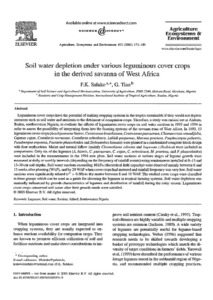| dc.contributor.author | Salako, F.K. |
| dc.contributor.author | Tian, G. |
| dc.date.accessioned | 2019-12-04T11:23:49Z |
| dc.date.available | 2019-12-04T11:23:49Z |
| dc.date.issued | 2003 |
| dc.identifier.citation | Salako, F.K. & Tian, G. (2003). Soil water depletion under various leguminous cover crops in the derived savanna of West Africa. Agriculture, Ecosystems & Environment, 100(2-3), 173-180. |
| dc.identifier.issn | 0167-8809 |
| dc.identifier.uri | https://hdl.handle.net/20.500.12478/4172 |
| dc.description.abstract | Leguminous cover crops have the potential of making cropping systems in the tropics sustainable if they would not deplete resources such as soil water and nutrients to the detriment of companion crops. Therefore, a study was carried out at Alabata, Ibadan, southwestern Nigeria, to evaluate the effects of leguminous cover crops on soil water suctions in 1993 and 1994 in order to assess the possibility of integrating them into the farming systems of the savanna zone of West Africa. In 1993, 13 leguminous cover crops (Aeschynomene histrix, Centrosema brasilianum, Centrosema pascuorum, Chamaecrista rotundifolia, Cajanus cajan, Crotalaria verrucosa, Crotalaria ochroleuca, Lablab purpureus, Mucuna pruriens, Psophocarpus palustris, Pseudovigna argentea, Pueraria phaseoloides and Stylosanthes hamata) were planted in a randomized complete block design with four replications. Maize and natural fallow (mainly Chromolaena odorata and Imperata cylindrica) were included as comparisons. Only six of the legumes (A. histrix, C. pascuorum, C. cajan, C. ochroleuca, M. pruriens, and P. phaseoloides) were included in the measurements in the 1994 new plots. Soil water suctions at various stages of legume growth were measured at daily or weekly intervals (depending on the frequency of rainfall events) using tensiometers installed at 0–15 and 15–30 cm soil depths. Soil water suctions exceeding 10 kPa (theoretical field capacity) were observed mainly between 6 and 12 weeks after planting (WAP), and by 20 WAP when cover crops had matured and rainfall frequency was very low. Soil water suctions were significantly related (r2>0.80) to dry matter between 8 and 10 WAP. The studied cover crops were classified in three groups which can be used as a guide for choosing the legumes in tropical farming systems. Soil water depletion was markedly influenced by growth characteristics of legumes and distribution of rainfall during the rainy season. Leguminous cover crops conserved soil water after their growth needs were satisfied. |
| dc.language.iso | en |
| dc.subject | Legumes |
| dc.subject | Soil Water |
| dc.subject | Suction |
| dc.subject | Alfisol |
| dc.title | Soil water depletion under various leguminous cover crops in the derived savanna of west africa |
| dc.type | Journal Article |
| dc.type | Journal Article |
| dc.description.version | Peer Review |
| cg.contributor.affiliation | University of Agriculture, Abeokuta |
| cg.contributor.affiliation | International Institute of Tropical Agriculture |
| cg.coverage.region | Africa |
| cg.coverage.region | West Africa |
| cg.coverage.country | Nigeria |
| cg.isijournal | ISI Journal |
| cg.authorship.types | CGIAR and developing country institute |
| cg.iitasubject | Agribusiness |
| cg.accessibilitystatus | Limited Access |
| local.dspaceid | 99738 |
| cg.identifier.doi | https://doi.org/10.1016/S0167-8809(03)00191-9 |

